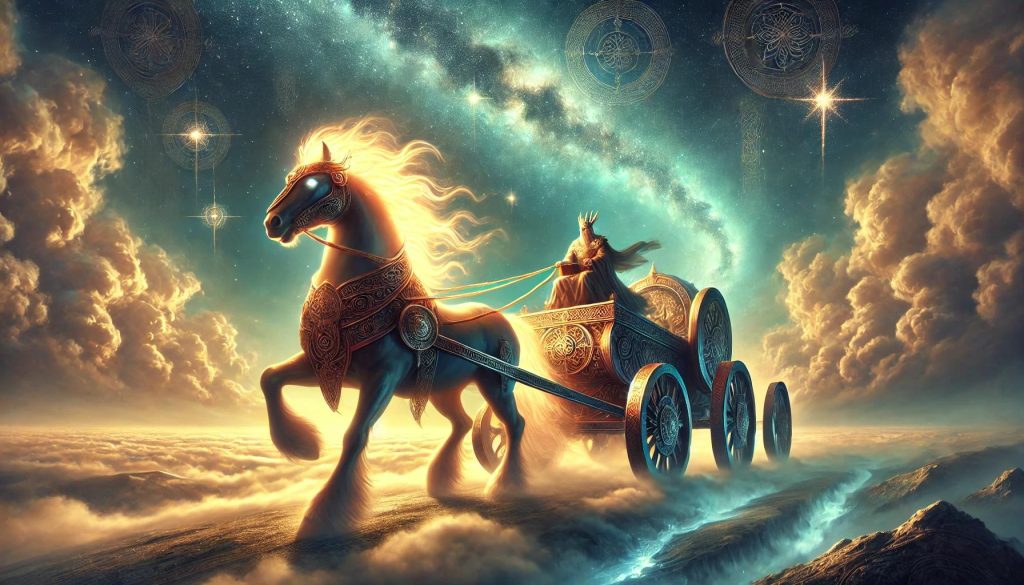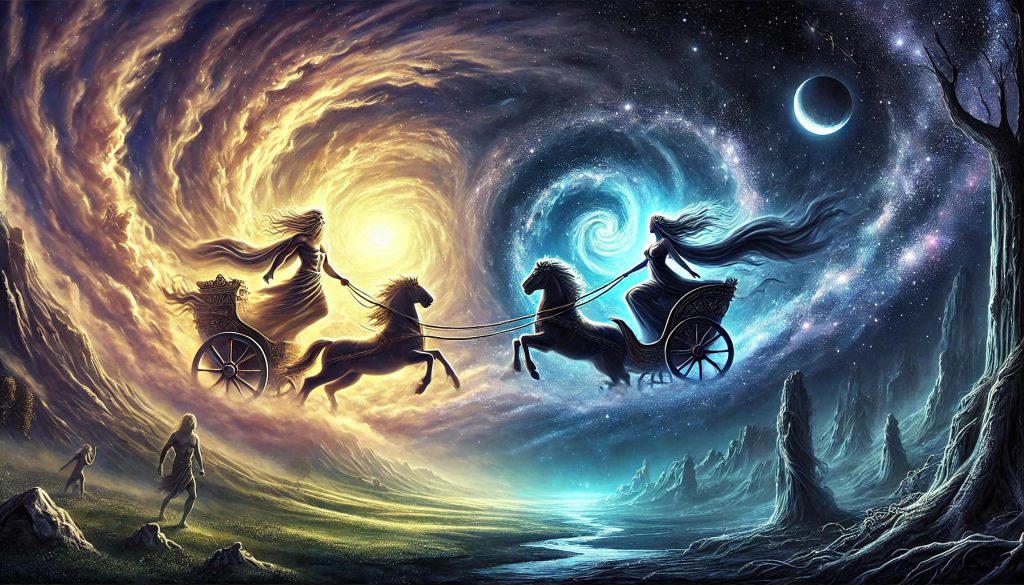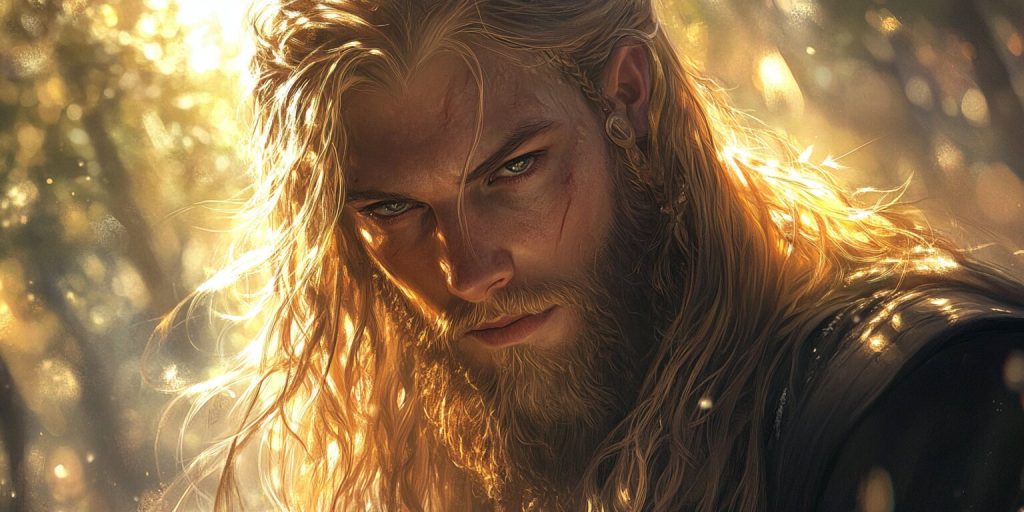Aesir Gods, Norse Cosmology, Norse Gods, Norse Mythology
Dagr Norse Mythology: The Bright God of Day and Light
Dagr is a shining figure in Norse mythology, personifying daylight. He is the god of daylight and dawn. Old Norse texts, like the Prose Edda, show him as a key part of the universe.
Dagr is special because he brings light and warmth to the world. He marks the start of a new day. This cycle is important in Norse stories, showing the rhythm of life.
In Norse myths, Dagr means more than just time. He stands for hope, renewal, and new beginnings. His stories remind us of the value of light in the dark Nordic world.
Introduction to Dagr in Norse Mythology
Norse mythology is full of interesting figures. Dagr is one of them, playing a big role in the world’s order. He is the god of day, bringing light and warmth to life.
Who is Dagr in the Norse Pantheon?
Dagr is part of the Aesir gods, representing daytime. He’s not just any god but a key part of Norse life. His coming means the night’s end and the day’s start, bringing light and hope to all.
The Significance of Dagr in Norse Cosmology
In Norse cosmology, Dagr is very important. His journey across the sky shows the passing of time and the cycle of life. He affects everything, from farming to war plans, making him crucial to Norse daily life.
Dagr’s Role as the Personification of Day
Dagr, the son of the god Dellingr, is more than just sunlight. He stands for hope, renewal, and new starts. His arrival means the beginning of work and action, opposite night’s stillness. This view of daytime deeply shaped Norse culture and beliefs.
The Origins of Dagr: Parentage and Family
In Norse mythology, Dagr’s family is linked to the heavens. His father, God Dellingr, is known for his bright nature, making Dagr a symbol of the day.
There is debate about who Dagr’s mother is. Some say it’s Jörð, the earth goddess. Others believe Nótt, the night, is his mother. This mystery makes Dagr’s story even more interesting.
Odin, the Allfather, is key in Dagr’s tale. He puts Dagr in the sky, where he travels daily, showing Odin’s power in shaping the world.
Dagr’s family ties go beyond his parents. His connections to other gods show the complex web of Norse mythology. These relationships highlight the intricate nature of the Norse pantheon.
Dagr’s Attributes and Characteristics
Dagr, the Norse god of day, shines bright and beautiful. He brings warmth and clarity to our world. Look at Dagr’s special qualities and how he lights up the Norse cosmos.
Physical Appearance of Dagr
Dagr is often seen as a radiant figure. His hair shines like golden sunbeams, and his eyes sparkle like a clear sky.
His skin glows with a soft, warm light. This light makes everything around him shine.
Dagr’s Powers and Abilities
Dagr’s main power is bringing forth the day. As he rides across the sky, darkness goes away. The world wakes up.
He can light up even the darkest places. Shadows flee, and hidden truths are revealed.
Symbols Associated with Dagr
Several symbols represent Dagr in Norse mythology:
- The rising sun symbolizes the start of a new day
- A golden chariot representing his journey across the sky
- A shining horse named Skinfaxi, whose mane brings light to the world
- A rooster, whose crow heralds the coming of dawn
These symbols show Dagr’s role as the bringer of light and the herald of each new day.
Dagr’s Chariot and Horse Skinfaxi
In Norse mythology, Dagr rides a chariot and a horse named Skinfaxi across the sky, a journey that took Dagr and his mother Nótt. This daily journey brings light to the world. Skinfaxi, meaning “shining mane” in Old Norse, is a fitting name for this celestial steed.

The horse Skinfaxi has a radiant mane that lights up the earth and sky. As Dagr guides his chariot through the heavens, Skinfaxi’s gleaming hair casts a warm glow. This light marks the arrival of day and chases away the darkness of night.
Dagr and Skinfaxi ride around the earth every 24 hours, creating the cycle of day and night. Their journey begins at dawn when they emerge from the eastern horizon. Skinfaxi’s brilliant mane bathes the world in sunlight as they traverse the sky. When evening approaches, they descend in the west, making way for Nótt, the goddess of night.
The chariot and horse of Dagr play a crucial role in Norse cosmology. They represent the regularity of celestial movements and the predictable rhythm of days. This concept was vital to the Norse people, who relied on these patterns for agriculture, navigation, and daily life.
The Relationship Between Dagr and Nótt
In Norse mythology, Dagr and Nótt are powerful duos who rule the cycle of time and show the natural order and balance in the Norse cosmos. Dagr, the god of day, and Nótt, the goddess of night, are the eternal dance of light and dark.
The Cycle of Day and Night in Norse Mythology
The Norse saw night and day as living beings, not just natural events. Nótt rides her chariot across the sky, bringing darkness. When she finishes, Dagr comes, bringing light. This cycle goes on forever, marking time in the Norse world.
Symbolism of Dagr and Nótt’s Union
The union of Dagr and Nótt is more than just light and dark. It shows the balance of opposing forces in nature. Their cycle mirrors the seasons, life’s ups and downs, and the world’s constant renewal.
Comparative Mythology: Day and Night Deities
Many cultures, not just the Norse, have day and night deities. In Greek mythology, Hemera and Nyx are day and night. The Aztecs had Tonatiuh and Yohualticetl. These stories show how ancient cultures explained life’s rhythm through divine figures.
Dagr in Norse Literature and Sagas
Dagr, the god of the day, is mentioned in many literary works. The Poetic Edda, a collection of Old Norse poems, mentions Dagr. In Vafþrúðnismál, Odin asks the giant Vafþrúðnir about Dagr’s beginnings and his role in the universe.
Snorri Sturluson’s Prose Edda, Gylfaginning, tells us more about Dagr. He says Dagr is Dellingr’s and Nótt’s son. He says Odin took Dagr and gave him a horse named Skinfaxi to pull his chariot, bringing light to mankind.
Skáldskaparmál, another part of the prose edda, sheds more light on Dagr’s role in Norse mythology. It lists poetic expressions for Dagr, showing his link to light and time.
- Vafþrúðnismál: Discusses Dagr’s parentage and cosmic role
- Gylfaginning: Describes Dagr’s appearance and his horse Skinfaxi
- Skáldskaparmál: Provides poetic references to Dagr
Dagr may not be the main character in Norse sagas. Yet, his influence is seen in many stories. The cycle of day and night, with Dagr and Nótt, is key to many Norse tales.
The Role of Dagr in Norse Cosmology
Dagr is key in Norse cosmology, showing how day and night work. His story in the creation myth shows how light and time matter in Norse beliefs.
Dagr’s Place in the Norse Creation Myth
In Norse myths, Dagr is Dellingr and Nótt’s son. This shows the balance between day and night and how time cycles in Norse myths.
Dagr’s Function in the Norse Concept of Time
Time in Norse myths is tied to Dagr’s journey across the sky, which took Dagr and his mother, Nótt, into account. His horse, Skinfaxi, brings light, marking time’s passage and daily life’s rhythm for the Norse.

Dagr’s Influence on Norse Daily Life and Rituals
Dagr’s impact was felt in Norse daily life. The sun’s rise, tied to Dagr, started the day. Farmers, sailors, and warriors planned their work by this cycle.
Norse rituals often honored Dagr at dawn. They made prayers and offerings for a good day. This shows how Norse myths and daily life were connected in ancient Scandinavian societies.
Dagr Norse Mythology: Connections to Other Norse Gods
Dagr is the god of day in Norse mythology. He is part of the Æsir and works with many gods and goddesses, each with a special role in the world.
Odin, the Allfather, is close to Dagr. Odin watches over all realms. He sees how important Dagr is for day and night.
Freyja, the goddess of love and fertility, is also connected to Dagr. Both are linked to light and life. Freyja is about love and nature, while Dagr is about the day’s light.
Sólbjartr, meaning “sun-bright,” is also tied to Dagr. They both stand for light and warmth. This light is what makes life grow in the Norse world.
- Dagr’s role as a fertility god is evident in his ability to bring light and growth to the world.
- His position among the Æsir emphasizes the importance of day and light in Norse beliefs.
- Dagr’s interactions with other gods reflect the interconnected nature of Norse mythology.
Dagr’s connections show his importance in Norse mythology. His ties with other gods show how the world is balanced, which is key in Norse stories.
Dagr in Archaeological and Historical Evidence
Archaeological finds show us the old Norse belief in Dagr. Runestones and inscriptions prove his big role in Norse culture. These stones, found across Scandinavia, sometimes talk about the god of day.
Runestones and Inscriptions
Runestones that directly mention Dagr are not common, but some inscriptions hint at day and light. These stones often mark big events or people, showing Norse love for daylight.
Norse Art and Iconography
Norse art also shows the importance of daylight. Many artifacts feature sun symbols and light themes. Even if they are not directly about Dagr, these pieces show how important daylight was in Norse myths.
Linguistic Traces
The word “day” in Swedish, Norwegian, and Danish comes from Old Norse “dagr”. This shows how Norse myths still shape our culture today.
Although there are few direct mentions of Dagr, runestones, Norse art, and language tell us a lot. They show Dagr was a key part of ancient Norse life.
Modern Interpretations and Cultural Impact of Dagr
Dagr, the Norse god of day, has found new life in today’s world. His story captivates many through books, TV shows, and video games. Popular series like “God of War” and “American Gods” have brought Norse myths to a wider audience.
This renewed interest has sparked modern interpretations of Dagr’s role in Norse mythology. The cultural impact of Dagr, the son of the god Dellingr, extends beyond entertainment. In the Norse revival movement, Dagr symbolizes new beginnings and hope.
Some neopagan groups honor Dagr and his mother, Nótt, in their practices. They see his daily cycle as a reminder of life’s constant renewal. This fresh take on ancient beliefs shows how old myths can still resonate in our modern world.
Artists and writers continue to draw inspiration from Dagr. His image appears in paintings, sculptures, and digital art. These works often portray him as a bringer of light, reflecting his mythological role.
Through these creative expressions, Dagr’s story stays alive. It bridges the gap between ancient Norse culture and our present day.

